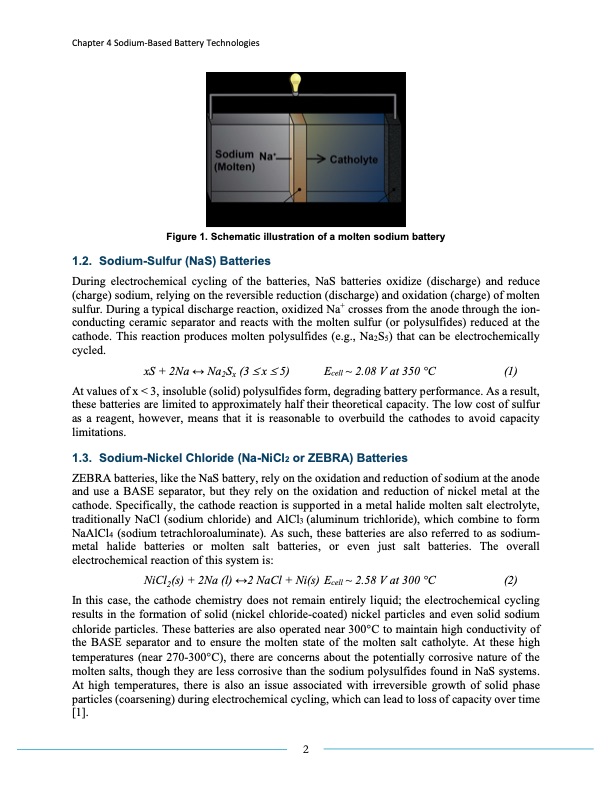
PDF Publication Title:
Text from PDF Page: 002
Chapter 4 Sodium-Based Battery Technologies Figure 1. Schematic illustration of a molten sodium battery 1.2. Sodium-Sulfur (NaS) Batteries During electrochemical cycling of the batteries, NaS batteries oxidize (discharge) and reduce (charge) sodium, relying on the reversible reduction (discharge) and oxidation (charge) of molten sulfur. During a typical discharge reaction, oxidized Na+ crosses from the anode through the ion- conducting ceramic separator and reacts with the molten sulfur (or polysulfides) reduced at the cathode. This reaction produces molten polysulfides (e.g., Na2S5) that can be electrochemically cycled. xS + 2Na ↔ Na2Sx (3 ≤ x ≤ 5) Ecell ~ 2.08 V at 350 °C (1) At values of x < 3, insoluble (solid) polysulfides form, degrading battery performance. As a result, these batteries are limited to approximately half their theoretical capacity. The low cost of sulfur as a reagent, however, means that it is reasonable to overbuild the cathodes to avoid capacity limitations. 1.3. Sodium-Nickel Chloride (Na-NiCl2 or ZEBRA) Batteries ZEBRA batteries, like the NaS battery, rely on the oxidation and reduction of sodium at the anode and use a BASE separator, but they rely on the oxidation and reduction of nickel metal at the cathode. Specifically, the cathode reaction is supported in a metal halide molten salt electrolyte, traditionally NaCl (sodium chloride) and AlCl3 (aluminum trichloride), which combine to form NaAlCl4 (sodium tetrachloroaluminate). As such, these batteries are also referred to as sodium- metal halide batteries or molten salt batteries, or even just salt batteries. The overall electrochemical reaction of this system is: NiCl2(s) + 2Na (l) ↔2 NaCl + Ni(s) Ecell ~ 2.58 V at 300 °C (2) In this case, the cathode chemistry does not remain entirely liquid; the electrochemical cycling results in the formation of solid (nickel chloride-coated) nickel particles and even solid sodium chloride particles. These batteries are also operated near 300°C to maintain high conductivity of the BASE separator and to ensure the molten state of the molten salt catholyte. At these high temperatures (near 270-300°C), there are concerns about the potentially corrosive nature of the molten salts, though they are less corrosive than the sodium polysulfides found in NaS systems. At high temperatures, there is also an issue associated with irreversible growth of solid phase particles (coarsening) during electrochemical cycling, which can lead to loss of capacity over time [1]. 2PDF Image | SODIUM-BASED BATTERY TECHNOLOGIES

PDF Search Title:
SODIUM-BASED BATTERY TECHNOLOGIESOriginal File Name Searched:
ESHB_Ch4_Sodium_Spoerke.pdfDIY PDF Search: Google It | Yahoo | Bing
Product and Development Focus for Salgenx
Redox Flow Battery Technology: With the advent of the new USA tax credits for producing and selling batteries ($35/kW) we are focussing on a simple flow battery using shipping containers as the modular electrolyte storage units with tax credits up to $140,000 per system. Our main focus is on the salt battery. This battery can be used for both thermal and electrical storage applications. We call it the Cogeneration Battery or Cogen Battery. One project is converting salt (brine) based water conditioners to simultaneously produce power. In addition, there are many opportunities to extract Lithium from brine (salt lakes, groundwater, and producer water).Salt water or brine are huge sources for lithium. Most of the worlds lithium is acquired from a brine source. It's even in seawater in a low concentration. Brine is also a byproduct of huge powerplants, which can now use that as an electrolyte and a huge flow battery (which allows storage at the source).We welcome any business and equipment inquiries, as well as licensing our flow battery manufacturing.| CONTACT TEL: 608-238-6001 Email: greg@salgenx.com | RSS | AMP |